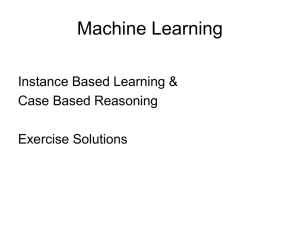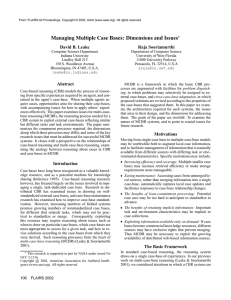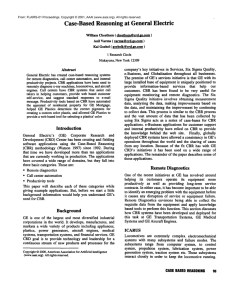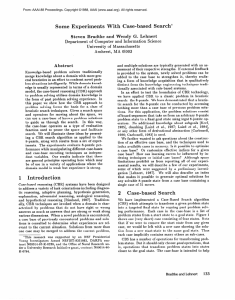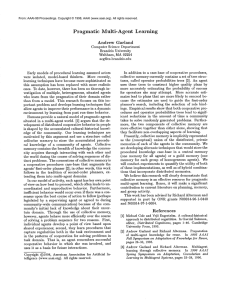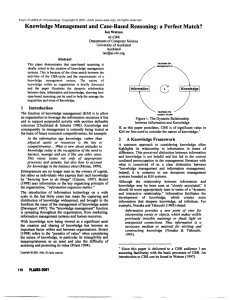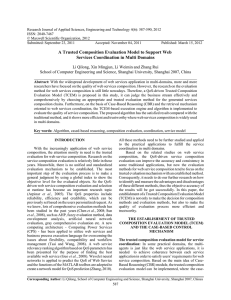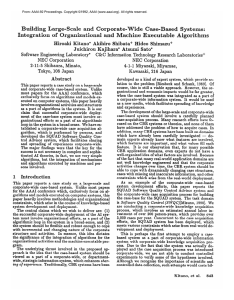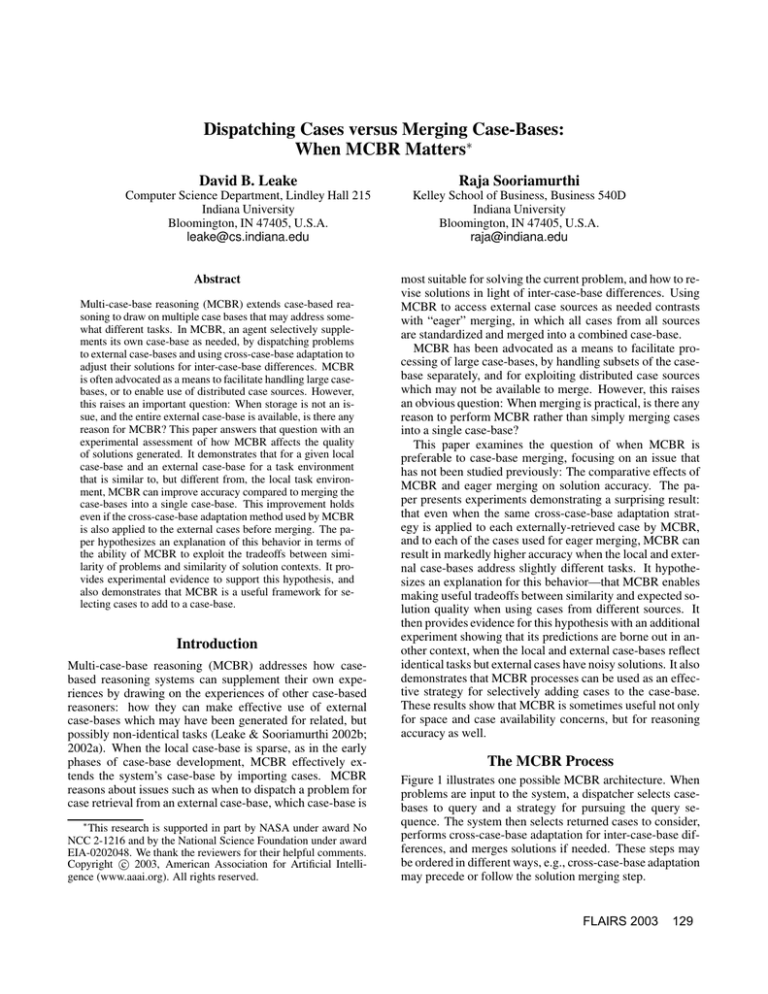
Dispatching Cases versus Merging Case-Bases:
When MCBR Matters∗
David B. Leake
Computer Science Department, Lindley Hall 215
Indiana University
Bloomington, IN 47405, U.S.A.
leake@cs.indiana.edu
Abstract
Multi-case-base reasoning (MCBR) extends case-based reasoning to draw on multiple case bases that may address somewhat different tasks. In MCBR, an agent selectively supplements its own case-base as needed, by dispatching problems
to external case-bases and using cross-case-base adaptation to
adjust their solutions for inter-case-base differences. MCBR
is often advocated as a means to facilitate handling large casebases, or to enable use of distributed case sources. However,
this raises an important question: When storage is not an issue, and the entire external case-base is available, is there any
reason for MCBR? This paper answers that question with an
experimental assessment of how MCBR affects the quality
of solutions generated. It demonstrates that for a given local
case-base and an external case-base for a task environment
that is similar to, but different from, the local task environment, MCBR can improve accuracy compared to merging the
case-bases into a single case-base. This improvement holds
even if the cross-case-base adaptation method used by MCBR
is also applied to the external cases before merging. The paper hypothesizes an explanation of this behavior in terms of
the ability of MCBR to exploit the tradeoffs between similarity of problems and similarity of solution contexts. It provides experimental evidence to support this hypothesis, and
also demonstrates that MCBR is a useful framework for selecting cases to add to a case-base.
Introduction
Multi-case-base reasoning (MCBR) addresses how casebased reasoning systems can supplement their own experiences by drawing on the experiences of other case-based
reasoners: how they can make effective use of external
case-bases which may have been generated for related, but
possibly non-identical tasks (Leake & Sooriamurthi 2002b;
2002a). When the local case-base is sparse, as in the early
phases of case-base development, MCBR effectively extends the system’s case-base by importing cases. MCBR
reasons about issues such as when to dispatch a problem for
case retrieval from an external case-base, which case-base is
∗
This research is supported in part by NASA under award No
NCC 2-1216 and by the National Science Foundation under award
EIA-0202048. We thank the reviewers for their helpful comments.
c 2003, American Association for Artificial IntelliCopyright gence (www.aaai.org). All rights reserved.
Raja Sooriamurthi
Kelley School of Business, Business 540D
Indiana University
Bloomington, IN 47405, U.S.A.
raja@indiana.edu
most suitable for solving the current problem, and how to revise solutions in light of inter-case-base differences. Using
MCBR to access external case sources as needed contrasts
with “eager” merging, in which all cases from all sources
are standardized and merged into a combined case-base.
MCBR has been advocated as a means to facilitate processing of large case-bases, by handling subsets of the casebase separately, and for exploiting distributed case sources
which may not be available to merge. However, this raises
an obvious question: When merging is practical, is there any
reason to perform MCBR rather than simply merging cases
into a single case-base?
This paper examines the question of when MCBR is
preferable to case-base merging, focusing on an issue that
has not been studied previously: The comparative effects of
MCBR and eager merging on solution accuracy. The paper presents experiments demonstrating a surprising result:
that even when the same cross-case-base adaptation strategy is applied to each externally-retrieved case by MCBR,
and to each of the cases used for eager merging, MCBR can
result in markedly higher accuracy when the local and external case-bases address slightly different tasks. It hypothesizes an explanation for this behavior—that MCBR enables
making useful tradeoffs between similarity and expected solution quality when using cases from different sources. It
then provides evidence for this hypothesis with an additional
experiment showing that its predictions are borne out in another context, when the local and external case-bases reflect
identical tasks but external cases have noisy solutions. It also
demonstrates that MCBR processes can be used as an effective strategy for selectively adding cases to the case-base.
These results show that MCBR is sometimes useful not only
for space and case availability concerns, but for reasoning
accuracy as well.
The MCBR Process
Figure 1 illustrates one possible MCBR architecture. When
problems are input to the system, a dispatcher selects casebases to query and a strategy for pursuing the query sequence. The system then selects returned cases to consider,
performs cross-case-base adaptation for inter-case-base differences, and merges solutions if needed. These steps may
be ordered in different ways, e.g., cross-case-base adaptation
may precede or follow the solution merging step.
FLAIRS 2003
129
For example, in an e-commerce application, a local merchant asked to estimate the price for a particular home theater system might first seek product information from its
own case-base, and, if no sufficiently similar cases were
available there, might dispatch the queries to other suppliers. It might then have to adjust the predicted prices based
on systematic inter-case-base differences (e.g., to convert
prices from Euros to dollars, if cases from a European supplier were being retrieved for American use).
The general MCBR framework may treat the local casebase in a special way, or may treat all case-bases, local and
external, according to a uniform set of dispatching criteria.
For example, if the local case-base has a low access cost, it
might be favored by a cost-based dispatching strategy, but if
it contains noisy cases, it might not be favored by a qualityoriented dispatching strategy. In what follows, for simplicity
we will assume that there is a single fixed local case-base
and a single fixed external case-base. However, we believe
that the results will apply to the more general model as well.
We have explored a dispatching method in which problems are dispatched to an external case-base if their distance
from the most similar local case exceeds a threshold, as well
as methods for automatically setting this threshold (Leake
& Sooriamurthi 2002b). The dispatching method treats the
external case-base and its similarity/retrieval method as a
“black box,” analyzing system performance on initial problems and selecting the dispatching threshold that gives the
best performance on that sample.
New Motivations for MCBR: Two Hypotheses
A number of potential benefits have been advanced for using
MCBR (Leake & Sooriamurthi 2002b). These include increasing efficiency—dividing up the case-base may increase
retrieval speed—augmenting coverage when needed, and exploiting distributed case information available on a per-case
basis. If external case-bases become commercial knowledge
resources, cases may be available individually, but without
access to the case-base as a whole.
Although there are compelling arguments for these advantages, they apply primarily when constraints on processing
speed, storage, or case access prevent merging the different case-bases. If those constraints do not apply, it would
be possible to simply import all external cases as a group,
perform cross-case-base adaptation on the entire group, and
then to reason from the single resulting case-base by the normal CBR process. However, this paper proposes two new
motivations that can make MCBR useful even when it is
practical to perform eager case-base merging:
1. Increasing solution quality: If two case-bases are
merged, all the cases in the resulting case-base are treated
uniformly for future retrievals, and the criterion for choosing between their cases is simply their similarity to
new problems. In MCBR, however, considerations beyond similarity—such as the quality of cross-case-base
adaptation—can be traded off against similarity. This
prompts the MCBR quality hypothesis: MCBR—lazy
retrieval and cross-case-base adaptation—should sometimes provide improved solution quality compared to
130
FLAIRS 2003
cross-case-base adapting all external cases and merging
them with the local case-base.
2. Guiding selective case addition: When a CBR system has insufficient competence, additional cases may be
needed. Research on case discovery examines how to select cases to add (McSherry 2000) and to identify cases to
fill competence gaps in the case-base (e.g., (McKenna &
Smyth 2001)). The MCBR process of dispatching cases
to external case-bases may be seen as another strategy for
case-base building, in which cases are added to fill only
those competence gaps that affect the current performance
of the CBR system, given the characteristics of local casebase, external case-base, and cross-case-base adaptation.
This prompts the MCBR case-base building hypothesis:
MCBR is a useful framework for guiding case addition.
These hypotheses are examined in the following sections.
Solution Quality Effects
for Merging vs. Dispatching
The success of MCBR depends on the availability of external case-bases to fill the local case-base’s competence gaps.
When such external case-bases are available, merging all
case-bases may seem to be a good alternative to MCBR’s
lazy merging: Eager merging avoids the overhead and potential for error of case dispatching. However, the MCBR
quality hypothesis suggests that MCBR may be advantageous even when merging is possible. To explore this hypothesis, we performed experiments on the quality effects
of eager vs. lazy merging.
Experimental Design
Our experiments compared lazy and eager case-base merging for the task of predicting median housing prices, using a
publicly-available data set from the Delve group. 1 This data
set includes 22,784 cases from the 1990 U.S. census, divided
by states. In the experiments, a randomly-selected subset of
the cases from one state was used as the “local” case-base,
and the complete case-base for another state was used as the
“external” case-base. The reason for including only a subset
of the local cases was to simulate the circumstances when
MCBR is expected to be useful: when the local case-base
has incomplete coverage, so additional cases are needed.
Here all cases use the same representation scheme, but the
price for a given set of property features will change based
on differences in the housing markets in different states. Intuitively, this prediction task can be seen as related to what
a real estate appraiser might do after moving to a new area,
when it is necessary to reason from a combination of local
and non-local experience. The state case-bases used (with
their abbreviations and sizes) are Alabama (AL, 470 cases),
Florida (FL, 752 cases), Indiana (IN, 590 cases), Illinois (IL,
1308 cases), Kentucky (KY, 471 cases), Mississippi (MS,
324 cases), and Ohio (OH, 1051 cases). In the experiments,
sparse versions of the IN case-base were used as the local
case-base. (An asterisk will designate the sparse version of
a case-base, e.g., IN* is the sparse version of the Indiana
1
http://www.cs.toronto.edu/˜delve/data/census-house/desc.html.
Case
Base
Problem
Solution
Selector
Standard CBR
Case
Dispatcher
Case
Base
...
Case
Base
Cross
CaseBase
Adapter
Reuse
Solution
Revise
Solution
Merger
Figure 1: Multi-case-base reasoning framework for drawing on a set of case-bases (Leake & Sooriamurthi 2002b)
Experimental Results on MCBR vs. Eager Merging
Figure 2 graphs the performance of MCBR vs. eager merging for IN* as the local case-base (here IN* contains 1%
of the original IN cases), and OH, IL, KY, respectively,
as external case-bases. The bars show the average performance for 10 versions of the local case-base, all containing the same number of randomly-selected cases. The first
bar shows the prediction performance of the local case-base
in isolation. Next, each pair of bars represents the merged
and dispatched behavior for MCBR with a given local casebase/external case-base combination. In all trials, including tests done with other case-base combinations, the performance of MCBR with case-dispatch is at least as good
as that of the merged case-base behavior and often noticeably surpasses it (e.g., for [IN*,KY], [AL*,MS]). Thus un-
MCBR
20
40
60
80
Merged CBs
0
case-base). Complete versions of the other case-bases were
taken as the external case-bases.
For each combination of sparse local case-base and external case-base, prediction quality was compared for lazy and
eager merging. Both conditions used test problems from the
original IN case-base, with leave-one-out cross validation.
The system automatically selected one of four cross-casebase adaptation strategies—identity, linear interpolation, or
two alternative case-based methods—expected to maximize
performance, using the inductive selection algorithm described in (Leake & Sooriamurthi 2002a), applied to the first
30 problems in the problem stream.
For the eager merging condition, the merged case-base
was generated by taking each case from the external casebase, applying cross-case-base adaptation, and adding the
cross-case-base adapted version to the local case-base. In
subsequent tests, normal CBR was done on the resulting
case-base, with prices predicted by averaging prices of the 3
nearest neighbors. For MCBR, a dispatching threshold was
selected by the learning method in (Leake & Sooriamurthi
2002a); when the distance between an input problem and the
most similar case in the local case-base exceeds the threshold, the problem is dispatched to the external case-base. The
external case for the most similar problem is then retrieved.
If it is more similar than the most similar local case, the
solutions of the three nearest neighbors in the external casebase are averaged, and the result is cross-case-base adapted
to yield a solution.
IN*
OH
IL
KY
Figure 2: Performance of eager merging vs. MCBR.
der some circumstances, eager merging can be detrimental
to the performance of the CBR system. The following section hypothesizes an explanation for that behavior.
Why MCBR May Increase Accuracy
Initially, it appears surprising that MCBR could improve
quality compared to normal CBR after merging all available
cases. At the very least, MCBR introduces a new potential
source of error, the decision of whether to process a case
in the local or (potentially less suitable) external case-base.
However, we believe that the benefit of MCBR can be explained by the added control MCBR gives the case selection
process, enabling using external cases only when they are
expected to be beneficial.
The value of using a case from a case-base with somewhat different characteristics depends not only on the similarity of the problem that case solves to the new problem,
but also on (1) the level of inter-case-base differences—the
extent to which the solutions for similar problems may differ in the local and external case-bases, and (2) the ability of cross-case-base adaptation procedures to compensate
for inter-case-base differences. Even if the external case is
very similar to the input problem, using that case may de-
FLAIRS 2003
131
L1
E2
E
L2
100
local cases
cblcl*
dispatching threshold
E1
similarity distance to target
Figure 3: Why case-base merging may decrease accuracy.
mcbr [ cblcl*, cb2ext’ ]
80
external cases
Prediction Accuracy
solution quality
L
merged [ cblcl*, cbext’ ]
60
40
20
0
0
0.2
0.4
0.6
0.8
1
% noise applied to external cases
grade performance if it suggests a less-reliable solution than
a more dissimilar case from the local case-base.
Figure 3 illustrates a potential bad result of eager merging. In the figure, the x-axis measures the similarity distance
of cases to the given target problem. The y-axis measures
the quality of the solution associated with a case. Here, if
the local and external case-bases are merged, the two external cases (E1 and E2) will be most similar to the target
problem. E2, the closest case, will be used to solve the target, resulting in a comparatively poor solution. However, if
cases in the external case-base systematically produce worse
solutions for a given similarity level, MCBR can take that
into account. By learning a sufficiently high dispatching
threshold (thereby preferring to solve problems using local
cases), MCBR can use only those external cases that are
so much more similar that their similarity counterbalances
their lower expected solution quality for a given similarity
level. In the figure, the dotted line on the x-axis indicates
a possible dispatching threshold to avoid the previous problem. In MCBR, because the distance from L1 to the target
problem is less than the dispatching threshold, L1’s (higher
quality) solution is used. To illustrate using the real estate
appraisal domain, a realtor may generate a better estimate
pricing a new house based on a somewhat dissimilar house
that is nearby, instead of a more similar house in a different area. However, using cases from another area might be
worthwhile if local cases are too dissimilar (e.g., pricing an
apartment when the only local cases are for houses).
Thus with the right dispatching criteria, MCBR can improve solution quality compared to eager merging, by taking
into account the quality of the external case-base and crosscase-base adaptation. Eager merging lacks that capability.
MCBR to Guide Use of Noisy Case-Bases
If the explanation in the previous section is correct, MCBR
should be beneficial when there are differences between the
expected quality of solutions from external and local casebases. To examine this hypothesis, we conducted an experiment in which the difference in expected quality comes from
noise in the external case-base, rather than from differences
in the tasks that the local and external case-bases address.
This experiment also tested the ability of our learning strategy for case dispatching to automatically adjust to changing
case-base characteristics.
132
FLAIRS 2003
Figure 4: Comparative performance of case acquisition
strategies: local CB (5% IN) and external noisy case-base
(10% IN with added noise).
In this experiment, we took two random samples of the IN
case-base, treating one as the local and the other as the external case-base. To study the effects of case-base quality, varying amounts of uniformly-distributed noise were probabilistically added to the solution part of the cases in the external
case-base. Our previous experiment on case-base merging
vs. MCBR was repeated on this combination of local and
external case-bases. Figure 4 graphs our results. We see
that when a noisy case-base is merged, performance of the
combined case-base drops. However, the dispatching learning strategy associated with MCBR is able to respond to the
noisiness of the external case-base and its reduced contribution to forming an effective solution. Hence as noise increases in the external case-base, the dispatching learning
strategy effectively shuts down case-dispatch, handles input problems locally, and thereby avoids the performance
degradation that results when the case-bases are merged.
This shows that when an external case-base is noisy, MCBR
can automatically self-adjust the whole system to compensate for decreased effectiveness of the external case-base,
again providing accuracy benefits compared to eager merging. This is consistent with our prediction.
Using MCBR to Guide Effective Case Addition
Although merging an entire external case-base may be detrimental when solutions in the external case-base are unreliable, it is clear that case additions may be beneficial, even
from a case-base that is less reliable than the local one.
For example, a new case from an external case-base may
fill a crucial competence gap. We hypothesized that, given
an original case-base and another case-base with less reliable solutions, MCBR is a good strategy for selecting which
cases to import from the external case-base. To explore this
hypothesis, we performed an experiment in which a very
sparse (1%) version of the Indiana case-base (IN*) was the
local case-base, and FL was the external case-base. We then
compared (1) performance using only IN*, (2) performance
using MCBR to select cases from FL to add, and adding the
cross-case-base adapted versions of those cases to the local case-base; and, (3) performance selecting random cases
from FL to add, and adding cross-case-base adapted versions
of those cases. In conditions (2) and (3), all tests added one
new case for each problem processed, and the same crosscase-base adaptation strategy was applied to all added cases.
The test simulated conditions in the early phases of using a
CBR system, when system competence is low and case addition is needed to increase competence.
The resulting competence was measured as the percentage of problems successfully solved. Tests were run 10
times, and results averaged. In these tests, on average
IN* solved 43% of the problems correctly. IN* with random (cross-case-base adapted) additions from FL increased
performance by 19% over the baseline (solving 51% of
the problems correctly), while adding cases determined by
MCBR gave a 30% increase over the baseline (solving 56%
of the problems correctly). Thus MCBR may provide useful
guidance for case addition during initial system use.
Relationships to Previous Research
The general idea of multi-case-base reasoning relates to research in distributed CBR, and in heterogeneous and distributed databases; some of these relationships are described
in (Leake & Sooriamurthi 2002a). Previous CBR research
has included research on problem dispatching (McGinty &
Smyth 2001) and on exploiting solutions generated by different agents (Ontañón & Plaza 2001). Ontañón and Plaza’s
approach differs from that of MCBR, however, in focusing on when a sufficiently good solution has been obtained,
rather than on deciding which case-base to query.
A significant body of CBR research studies case-base
maintenance (e.g., (Leake et al. 2001)). MCBR can be
seen as performing a form of “lazy” case-base maintenance:
Cases are imported, and converted to local requirements by
cross-case-base adaptation, as needed. A perhaps-surprising
result from our experiments is that for accuracy, this lazy
maintenance, done as-needed, can provide better results than
eager maintenance.
Future Directions
As described previously, inter-case-base differences may
have a strong effect on the expected usefulness of cases with
given similarity levels. Although our experiments show that
threshold-based dispatching can help address this when local and external case-bases have comparable similarity metrics, we anticipate that better performance could be achieved
by a richer model of the relationships between the similarity criteria of two case-bases. We note that the MCBR dispatching process can be seen as imposing a new similarity
measure on the space, based on expected usefulness of cases
from different case-bases. Combining learned dispatching
criteria with the case-bases’ own similarity metrics is a convenient “knowledge light” way to reflect utility differences
between cases in different case-bases. However, how additional knowledge could be used, how to decide when to use
MCBR, rather than merging, and how to refine the dispatching threshold over time are all interesting open questions.
Our tests suggest that MCBR may also have value for
selective case addition. This potentially includes updating
legacy case-bases, by treating any already-updated cases as
the “local” case-base and the legacy case-base as the “external” case-base, and automatically importing and cross-casebase adapting the legacy cases needed during processing.
Conclusion
Multi-case-base reasoning (MCBR) enables an agent to selectively augment its own case-base as needed, drawing on
external case-bases and adjusting their solutions for intercase-base differences. MCBR is often motivated by the desire to support experience-sharing without requiring access
to a complete external case-base, and without the storage
required to merge complete case-bases. Although its advantages are clear when those constraints are significant, this
appeared to limit its usefulness to situations when those constraints hold. This paper shows that MCBR may have two
additional benefits: Increasing solution accuracy compared
to eager merging, and guiding case-base building. For a
given local case-base and external case-base for a similar
but different task, MCBR can improve accuracy compared to
merging both case-bases into a single case-base, even if the
same cross-case-base adaptation process is applied to both
cases-bases. The paper hypothesizes an explanation of this
behavior in terms of a tradeoff between similarity of problems and similarity of solution contexts, and demonstrates
that the expected benefits also apply when using local and
external case-bases developed for the same task environment, but with differing levels of reliability. These results
make a case for the broader usefulness of MCBR.
References
Leake, D., and Sooriamurthi, R. 2002a. Automatically selecting strategies for multi-case-base reasoning. In Craw,
S., and Preece, A., eds., Proceedings of ECCBR-2002,
204–219. Berlin: Springer Verlag.
Leake, D., and Sooriamurthi, R. 2002b. Managing multiple case-bases: Dimensions and issues. In Proceedings of
FLAIRS-2002, 106–110. Menlo Park: AAAI Press.
Leake, D.; Smyth, B.; Yang, Q.; and Wilson, D., eds. 2001.
Maintaining Case-Based Reasoning Systems. Blackwell.
Special issue of Computational Intelligence, 17(2), 2001.
McKenna, E., and Smyth, B. 2001. Competence-guided
case discovery. In Research and Development in Intelligent
Systems XVIII: Proceedings of ES 2001. Berlin: SpringerVerlag.
McGinty, L., and Smyth, B. 2001. Collaborative casebased reasoning: Applications in personalised route planning. In Proceedings of ICCBR-2001. Berlin: Springer
Verlag.
McSherry, D. 2000. Automating case selection in the construction of a case library. Knowledge-Based Systems 13(23):133–140.
Ontañón, S., and Plaza, E. 2001. Learning when to collaborate among learning agents. In Machine Learning: ECML
2001, 395–405. Berlin: Springer-Verlag.
FLAIRS 2003
133

